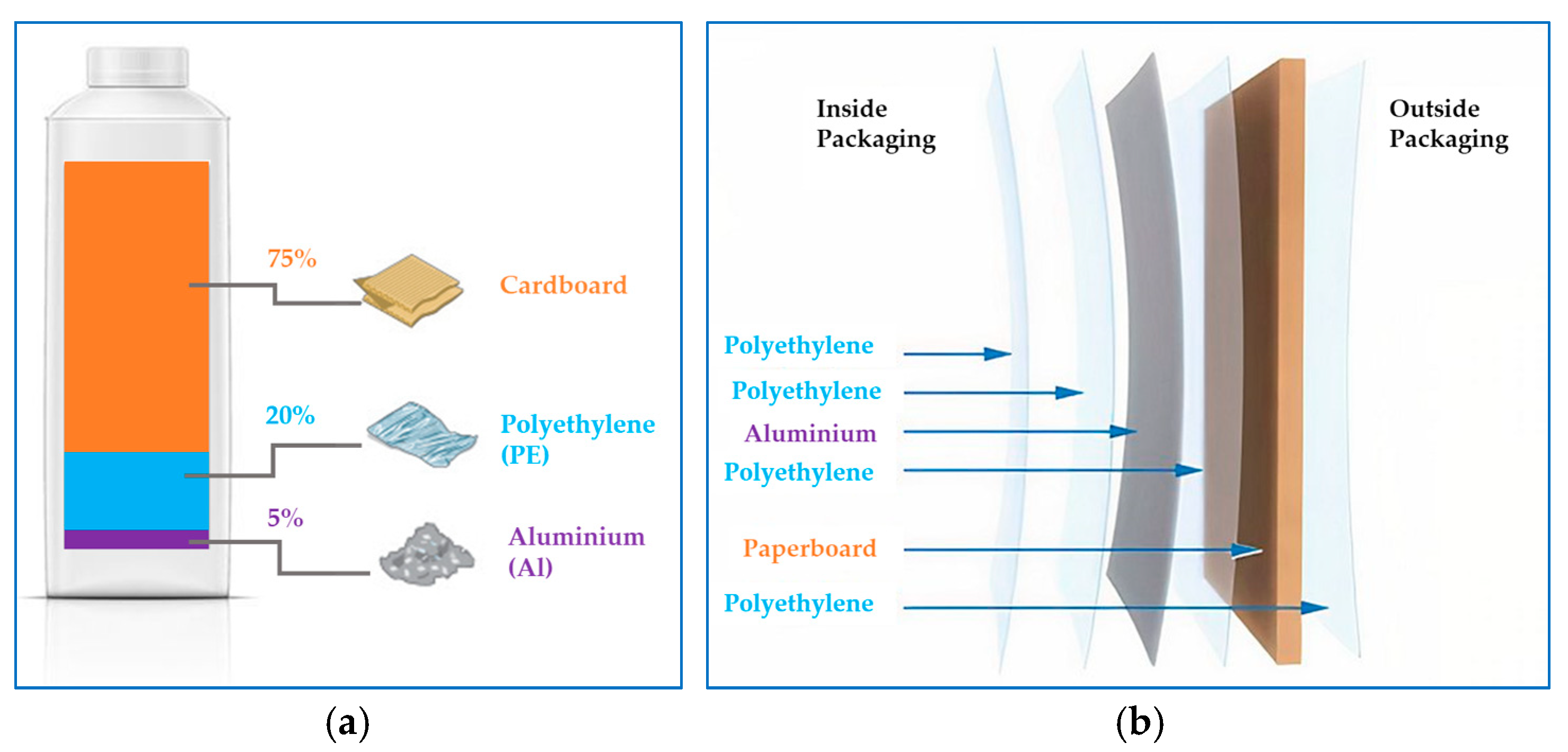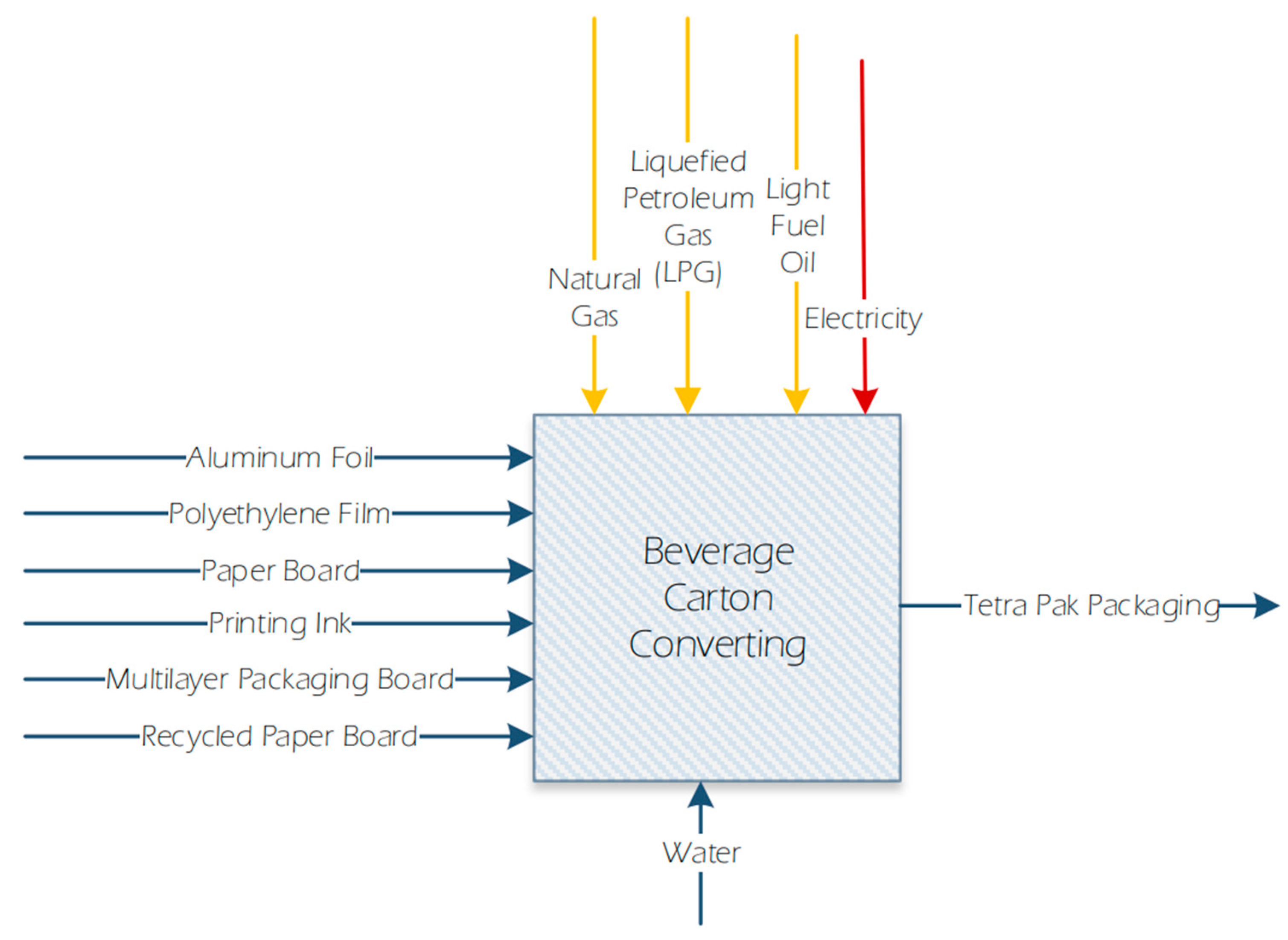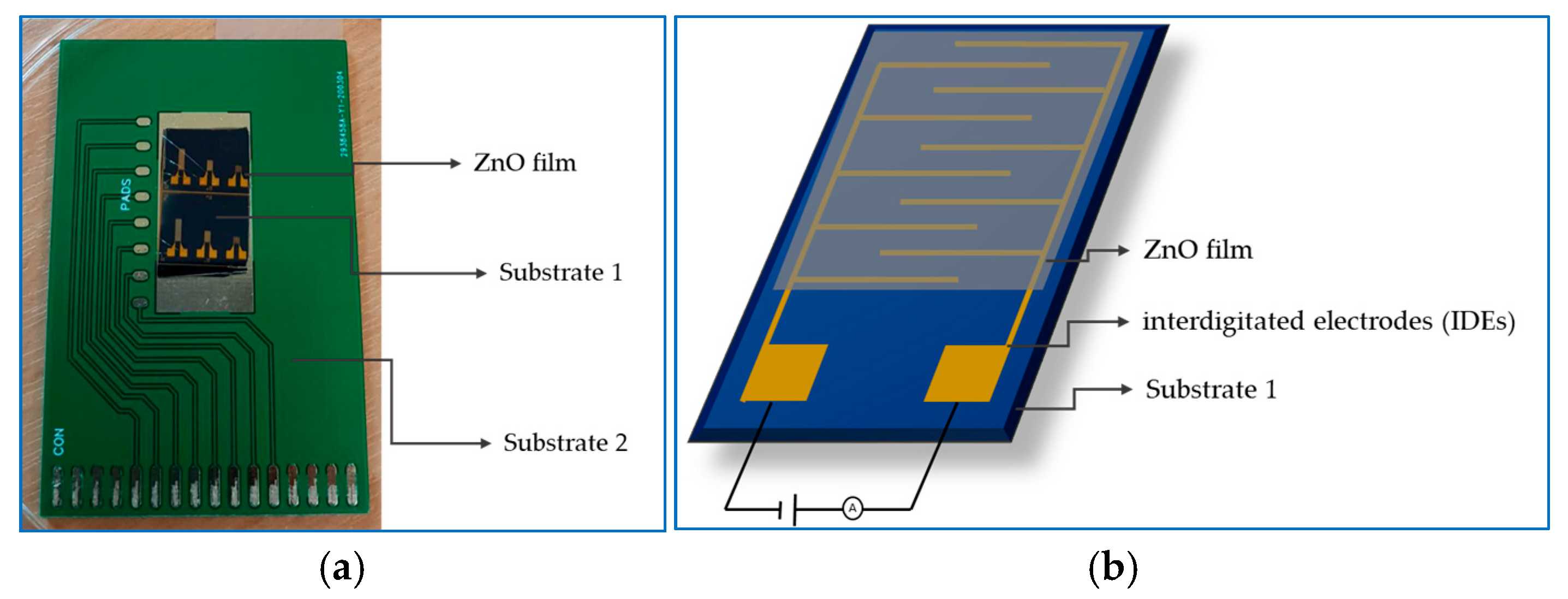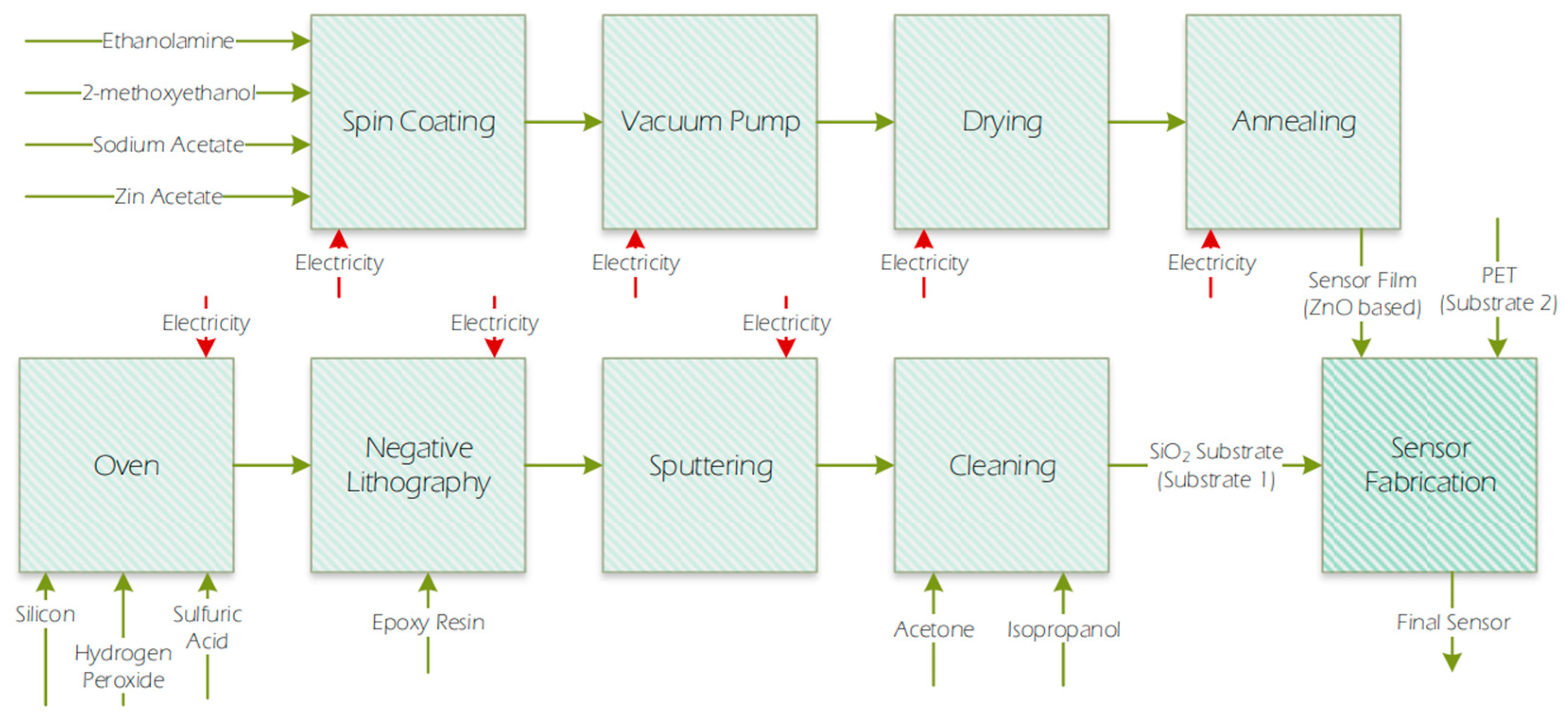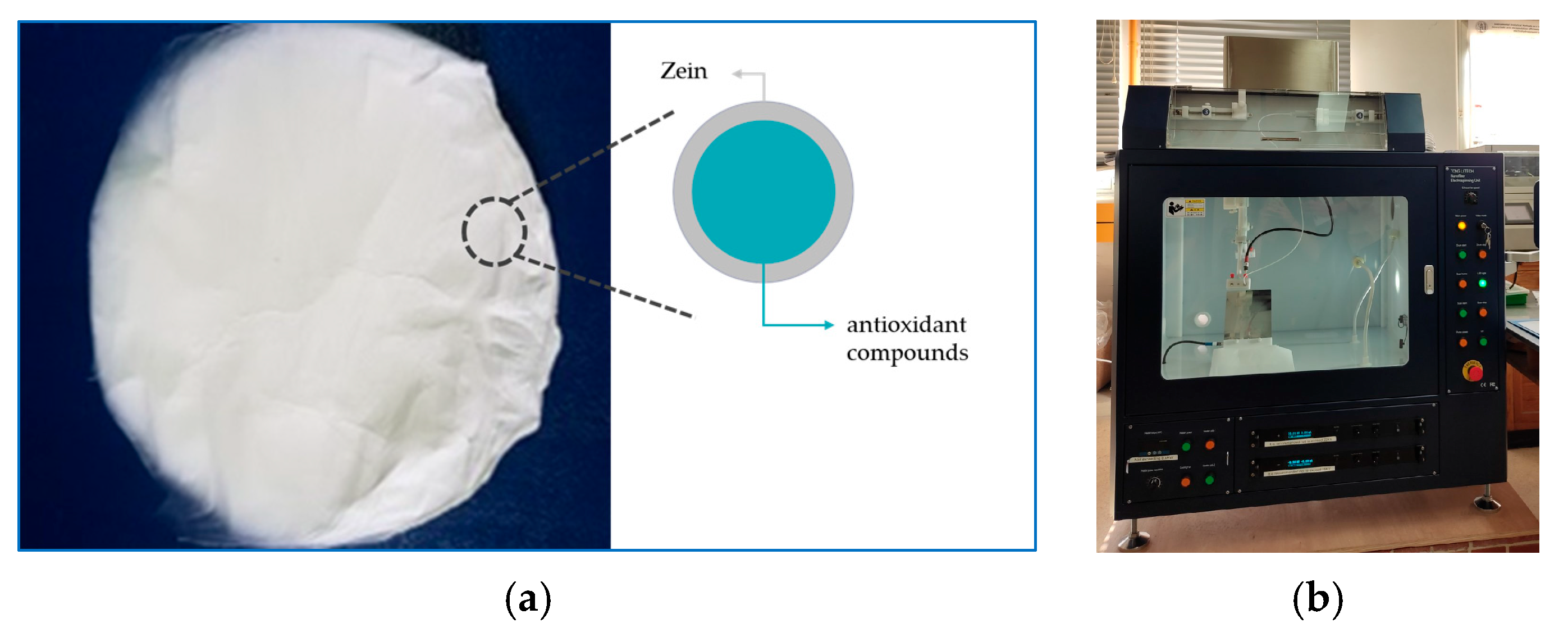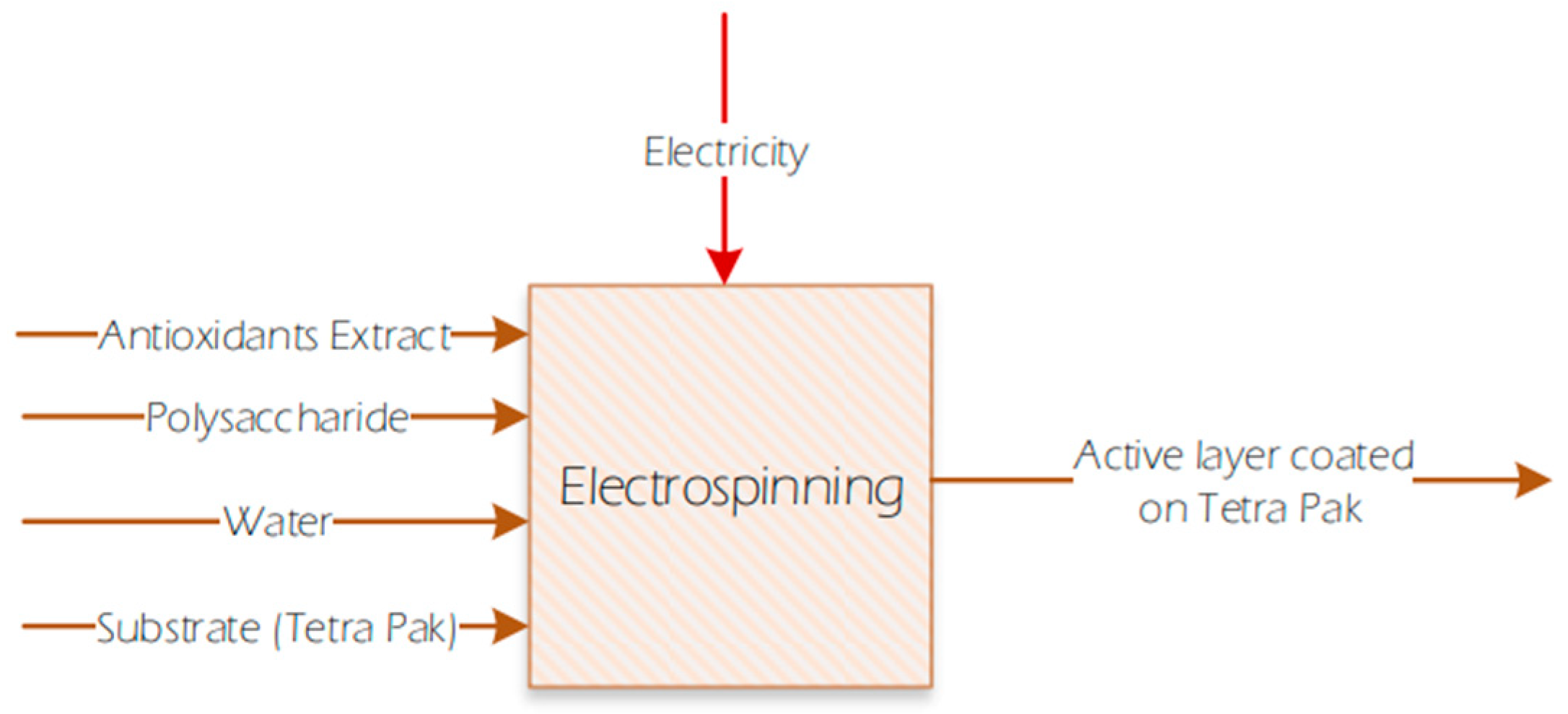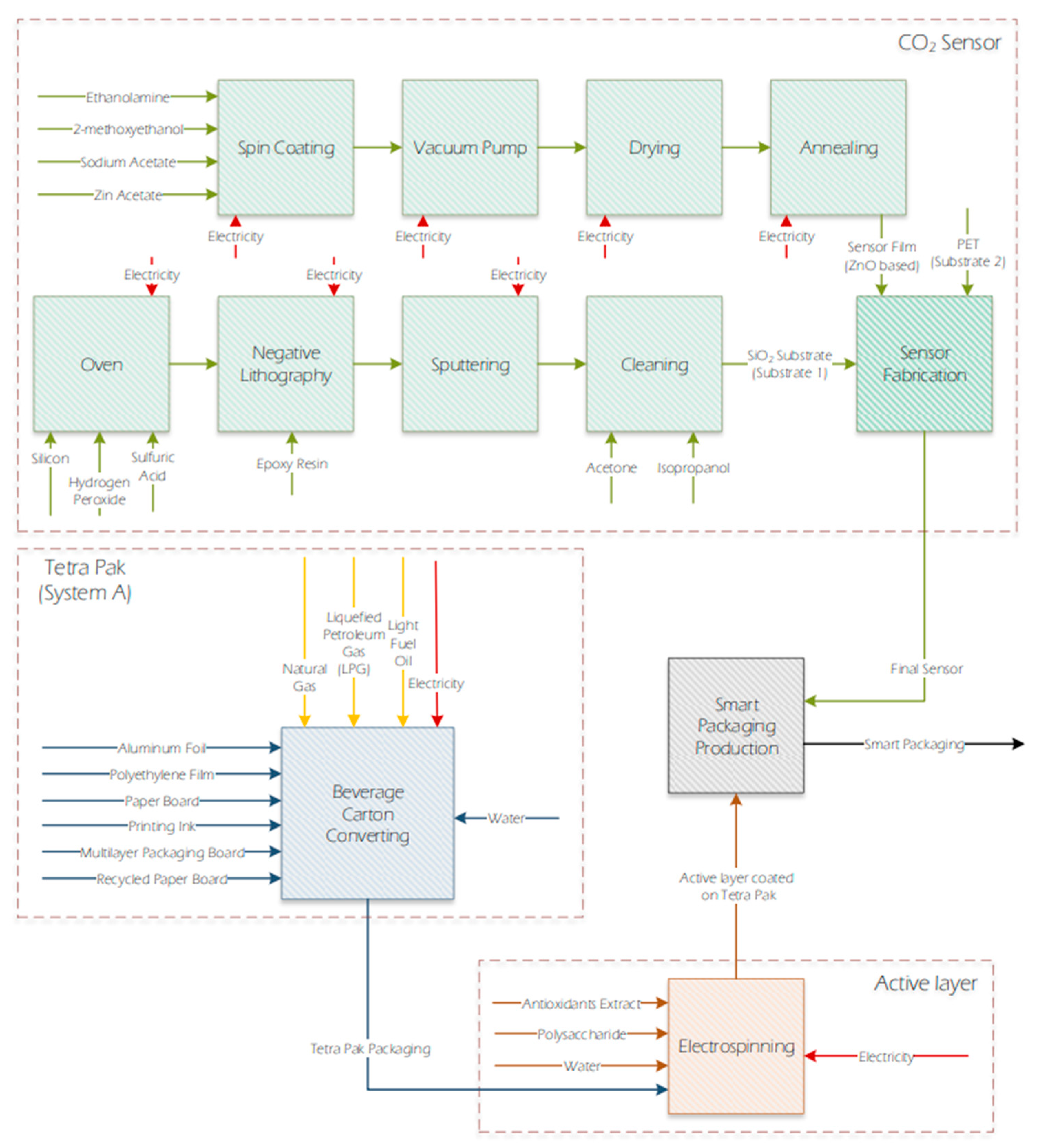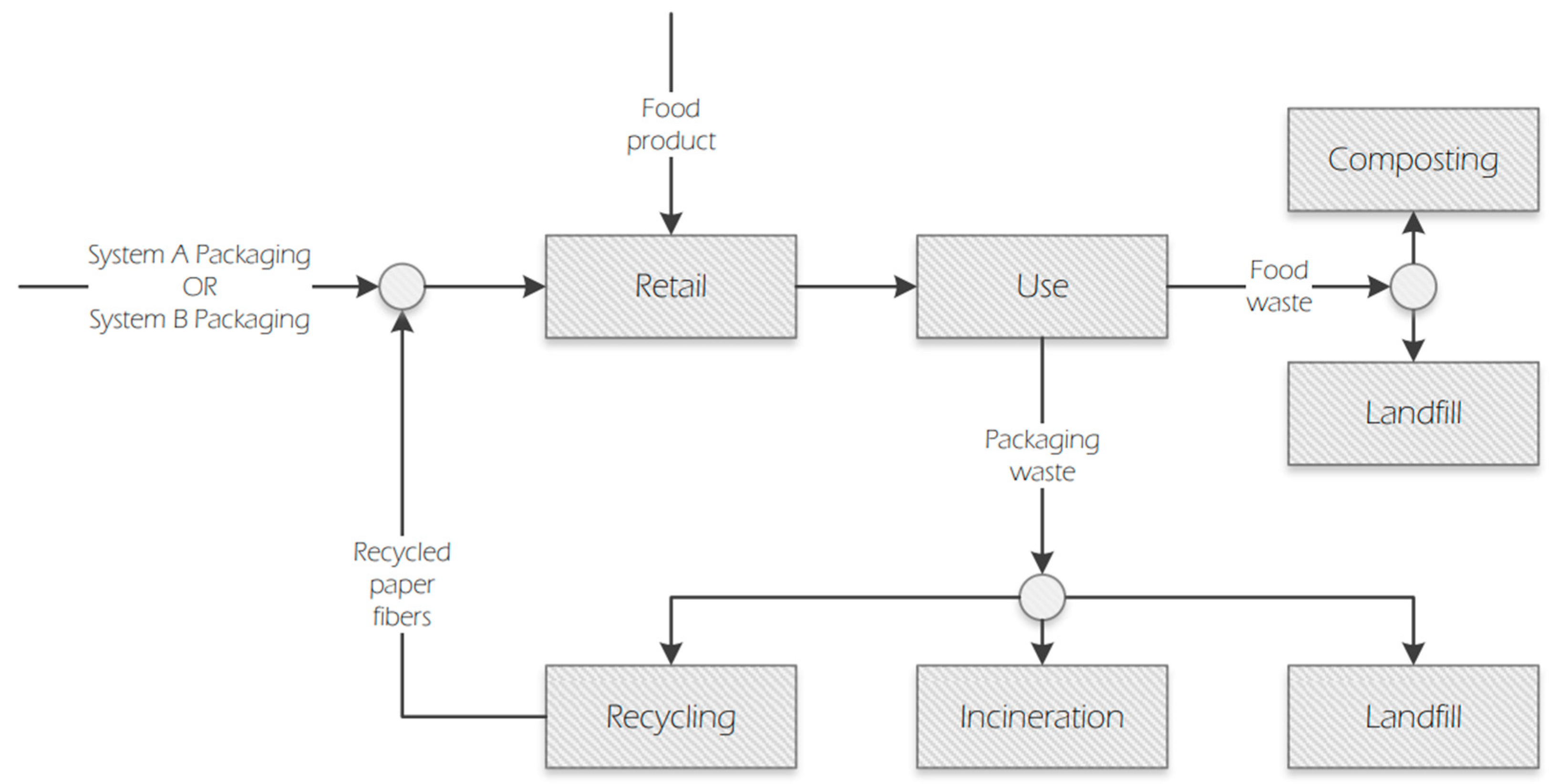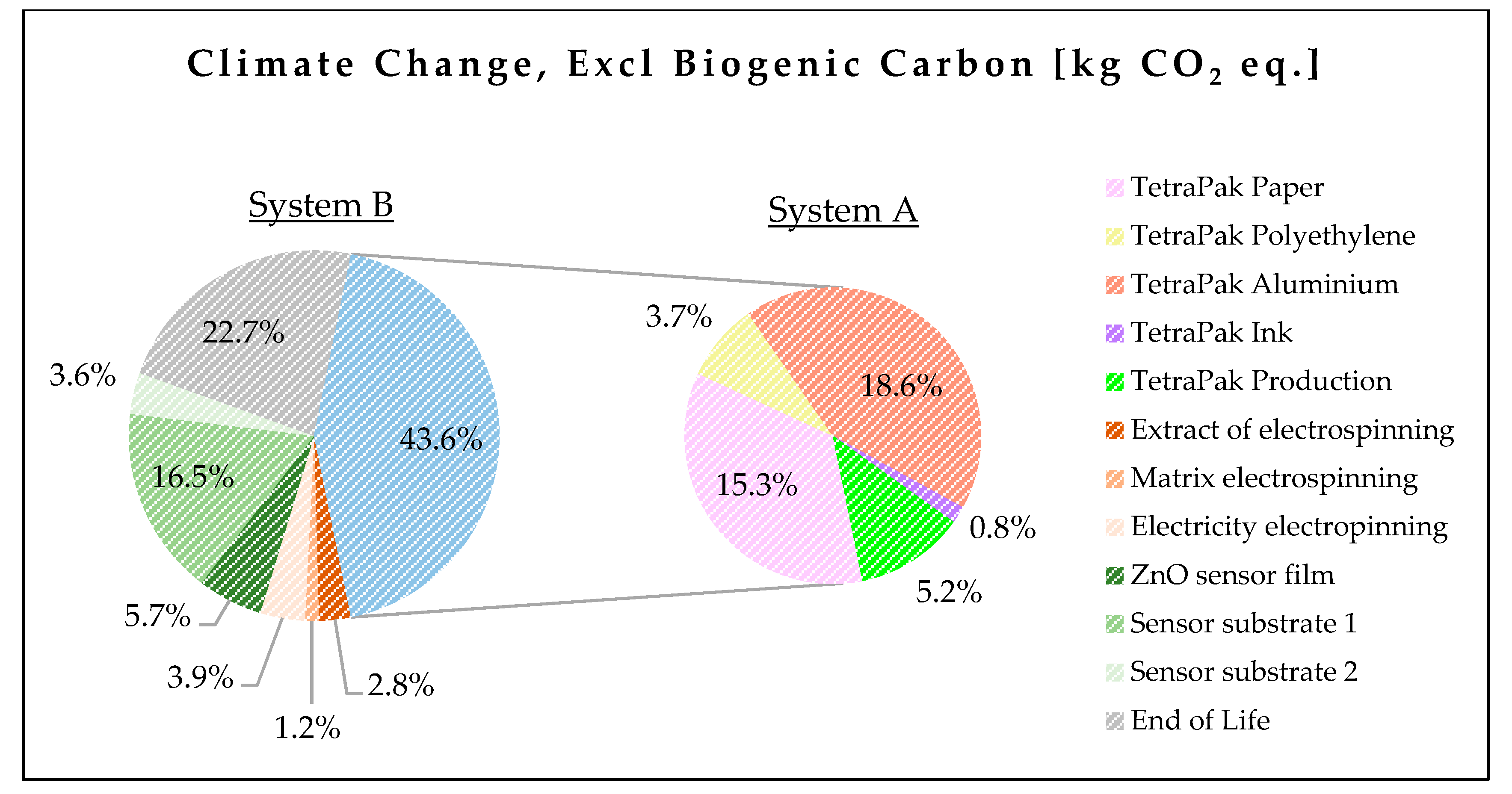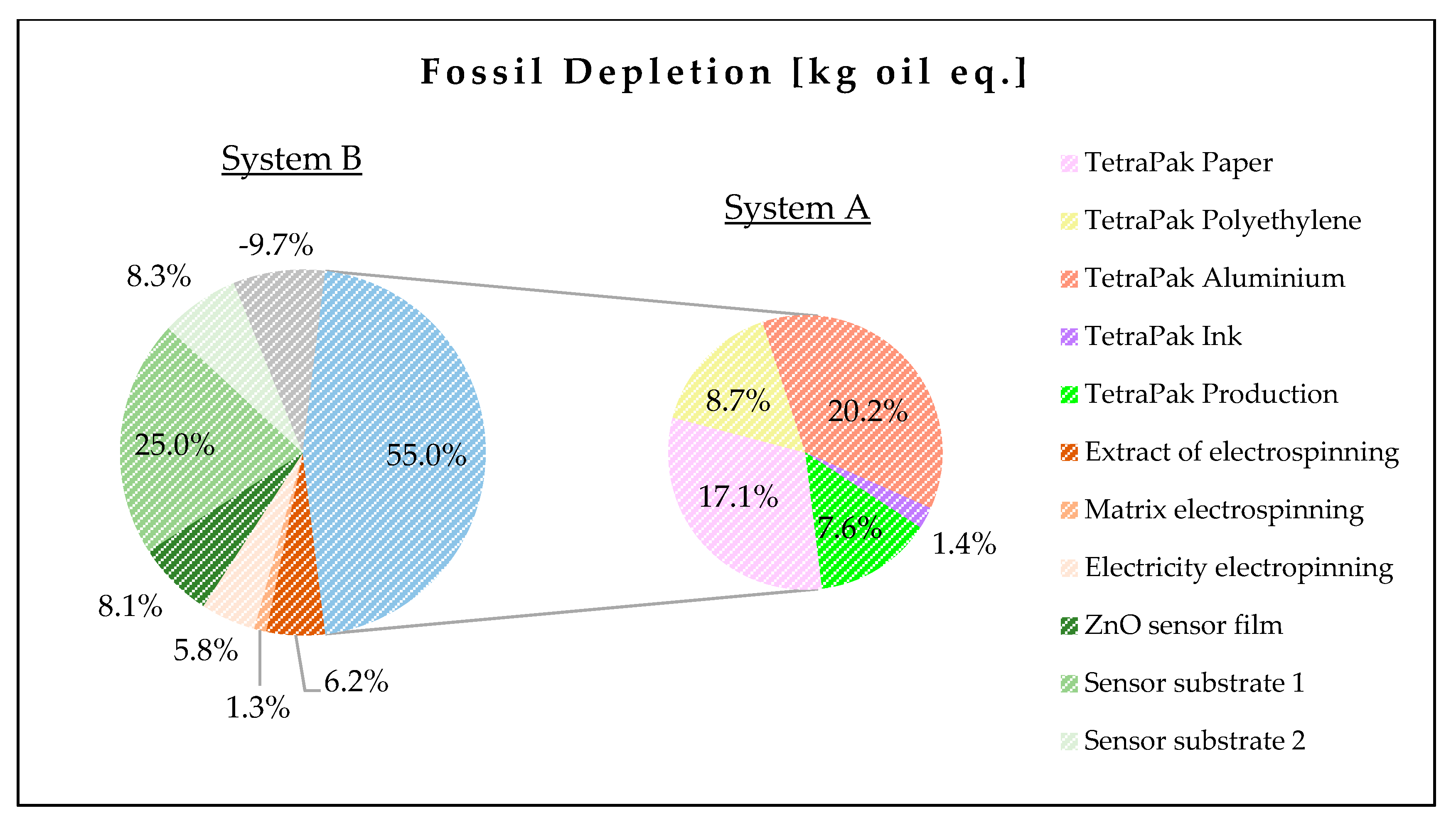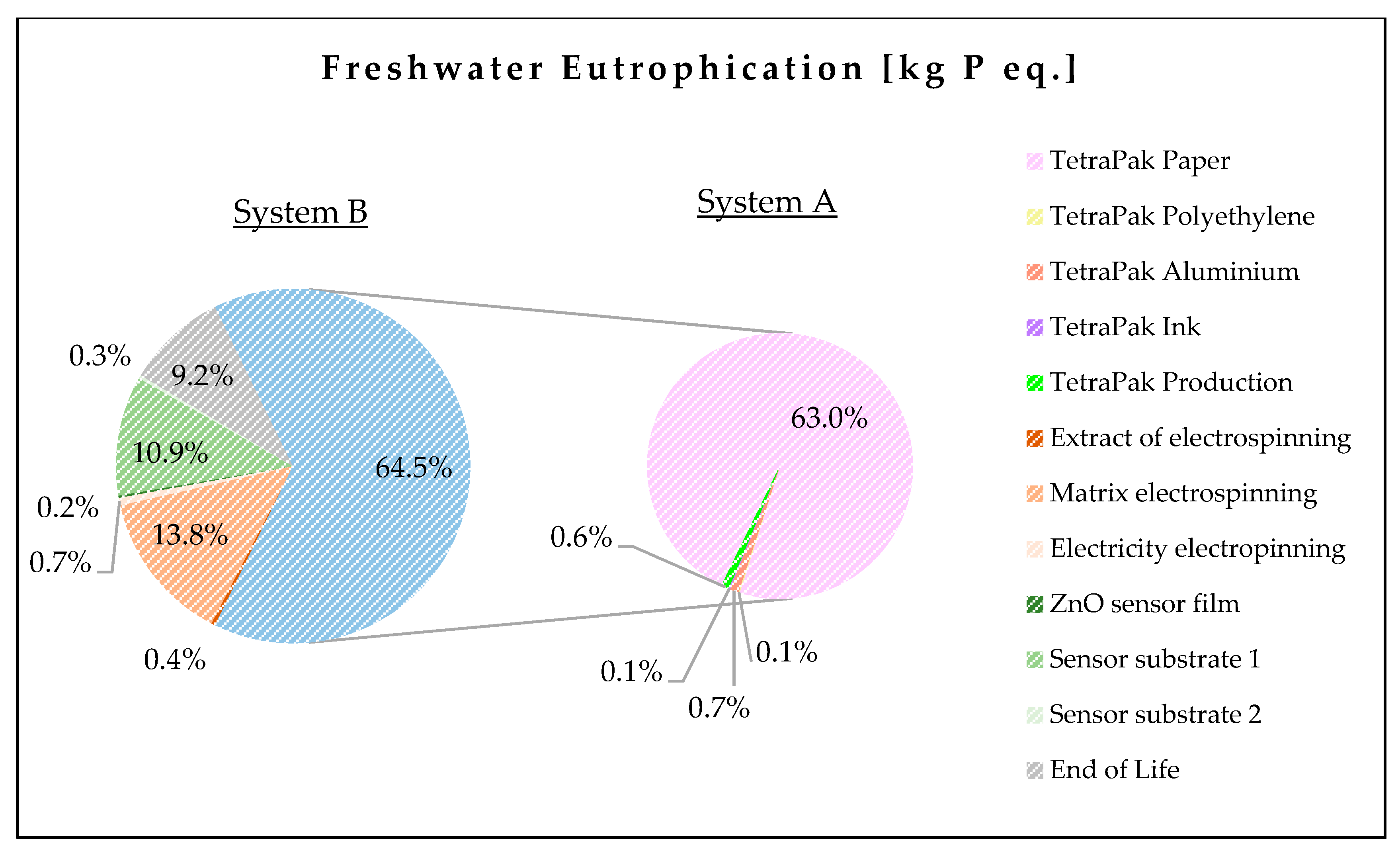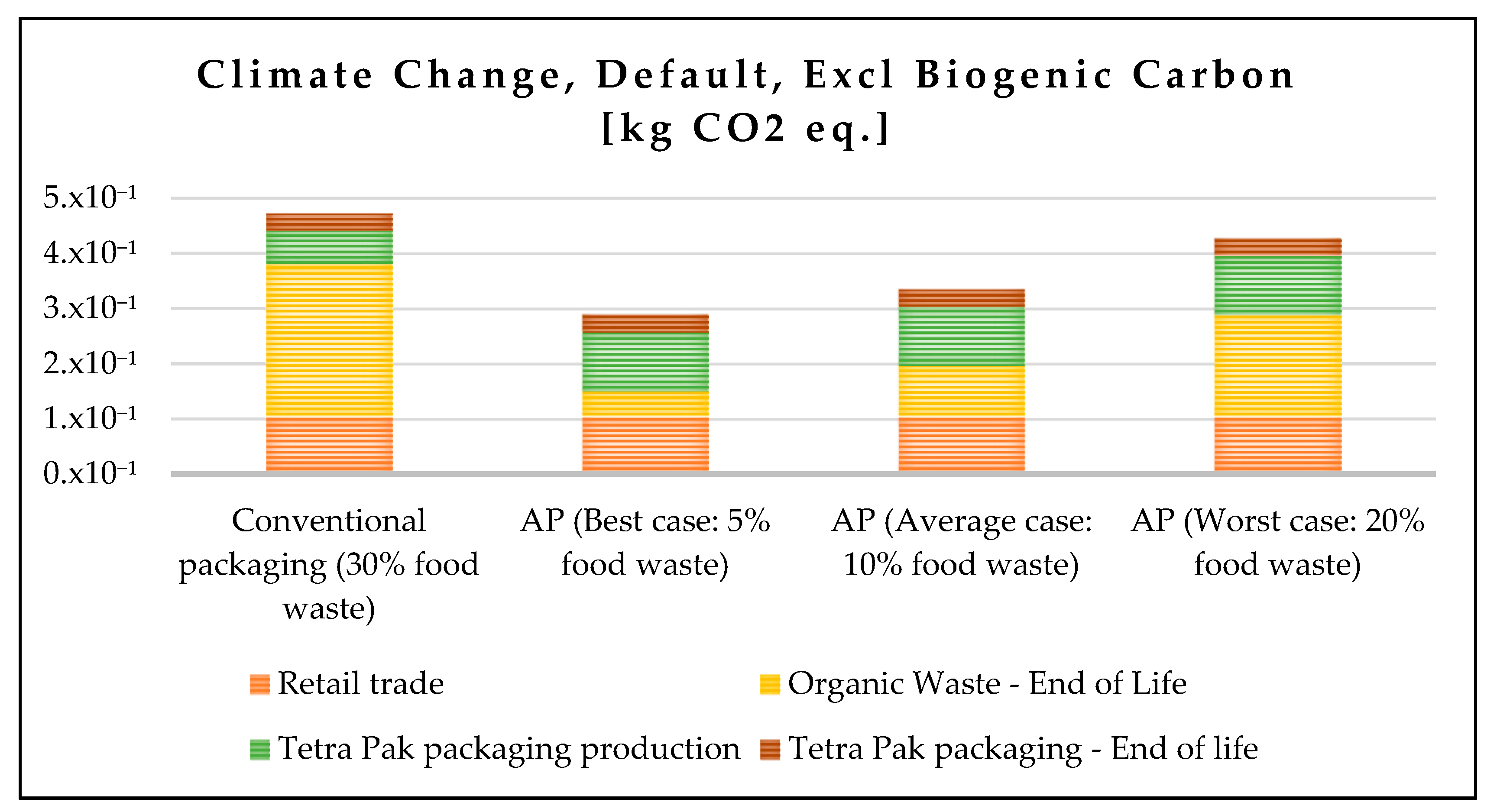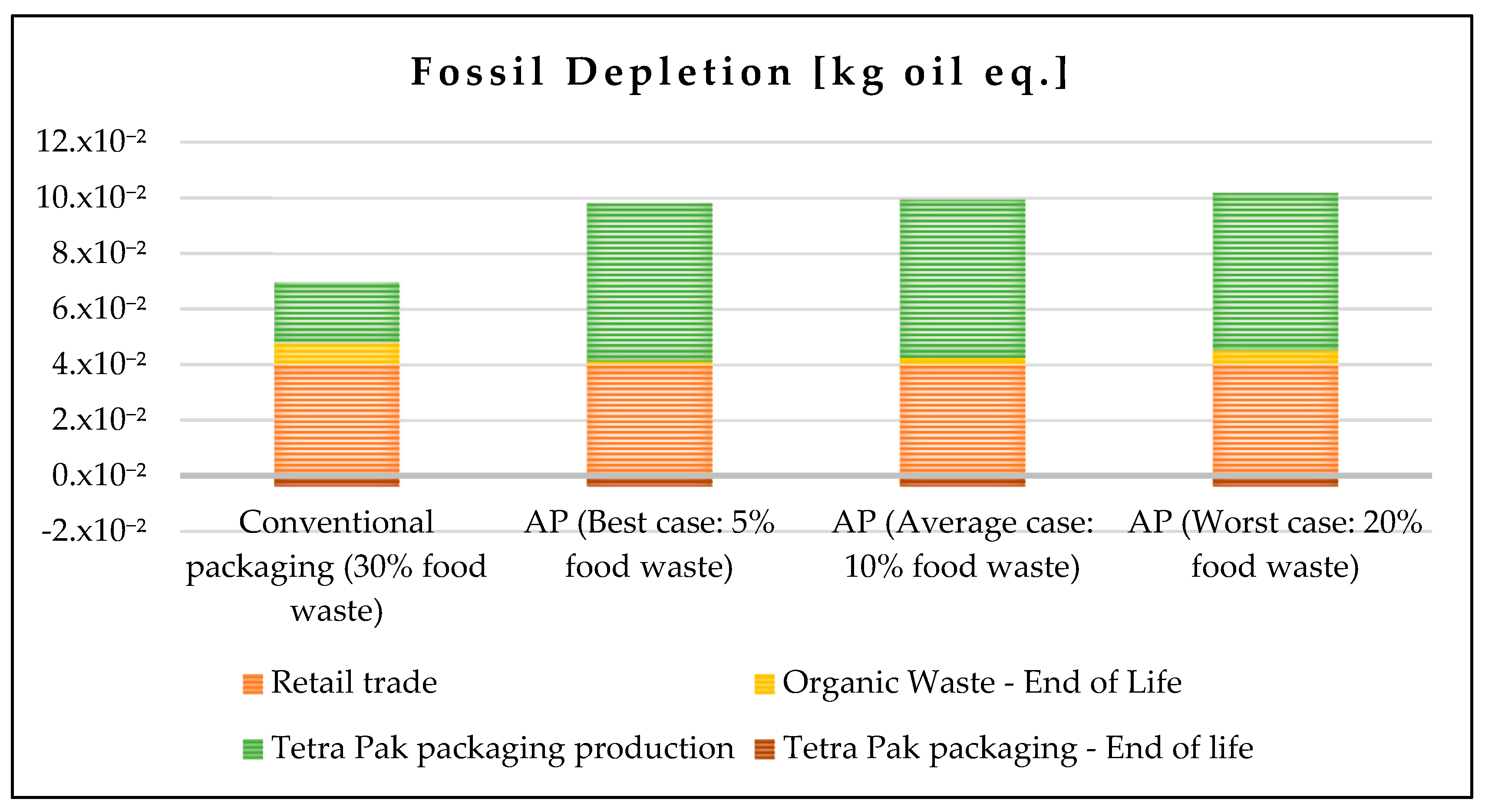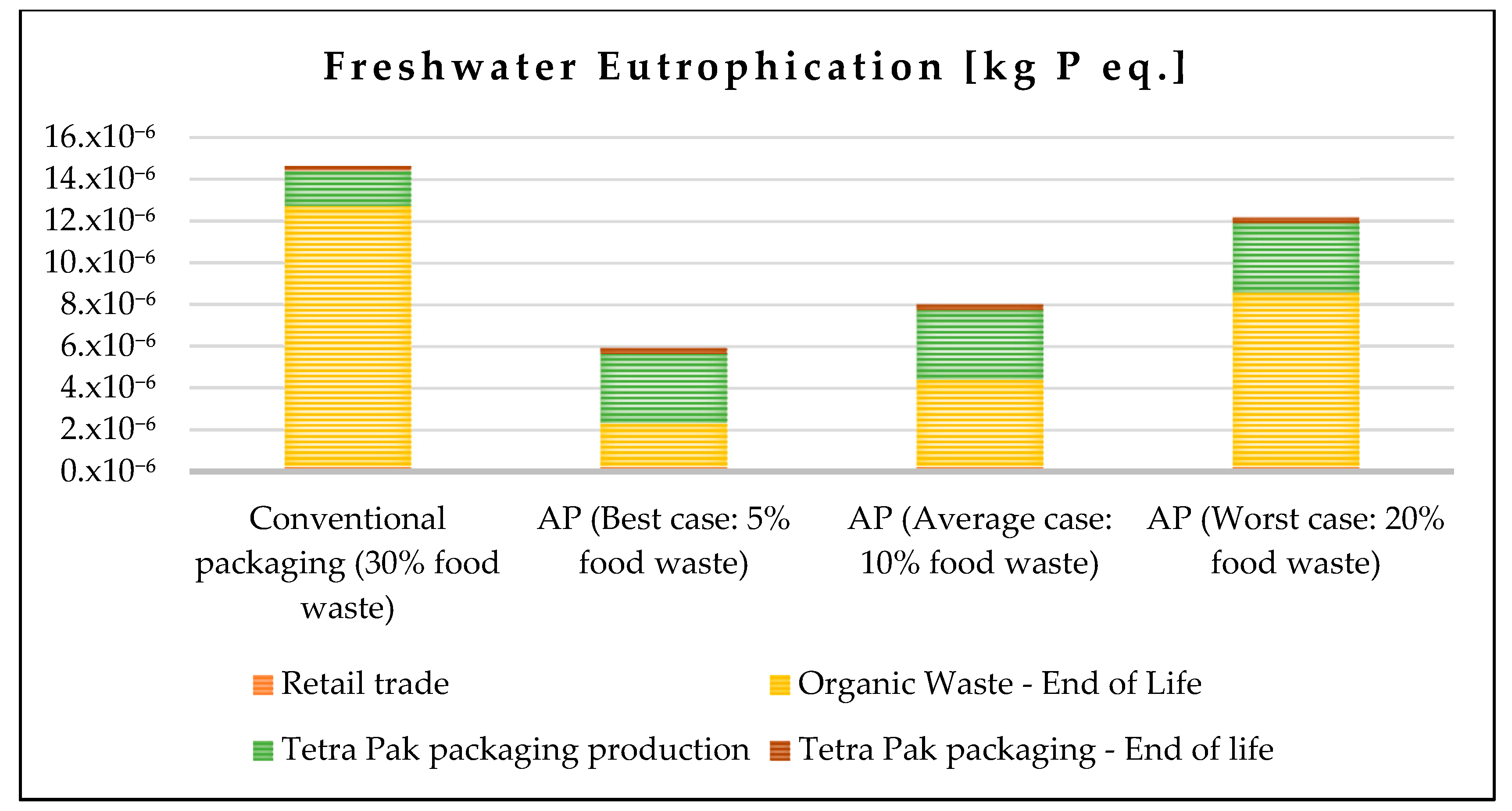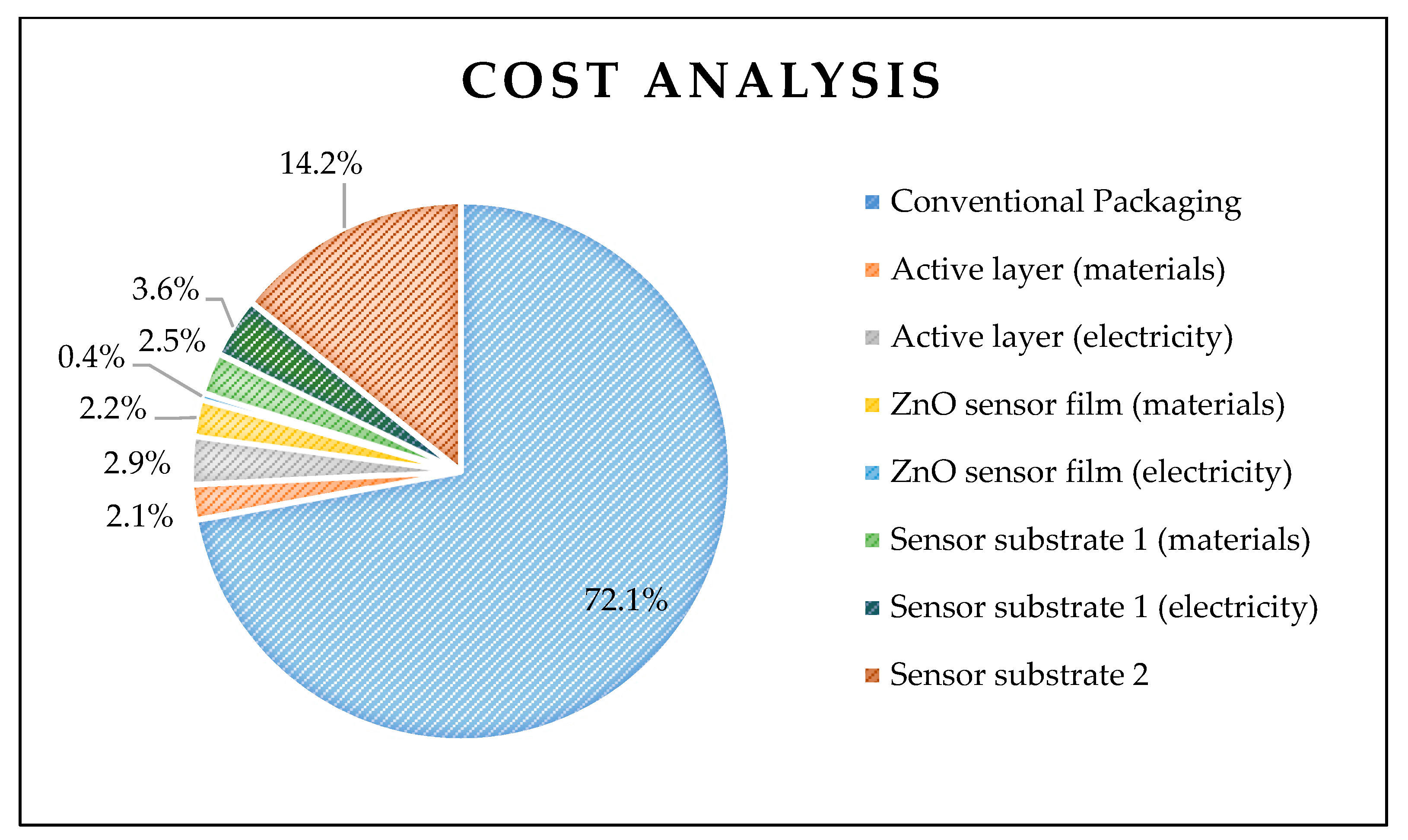3.1. Life Cycle Impact Assessment (LCIA)
The results of the LCA are presented in
Table 8, showing the calculated values of the ReCiPe 2016 (H) midpoint indicators for Smart TetraPak Packaging (System B). These values are the sum of the contributions from the production of conventional Tetra Pak packaging, the sensor and the electrospun layer, as well as the packaging’s end-of-life phase, without including the retail, use, and end of life of the contained food.
It is noteworthy that consistency of the comparative LCA analysis between conventional and smart Tetra Pak packaging, both packaging systems follow similar waste management pathways, namely incineration, recycling, or landfill, as explained in
Section 2.1.2.
Among the various midpoint indicators, three of them were identified as particularly significant and are discussed in detail, including the contribution of each component of smart packaging. These indicators are “Climate Change”, “Fossil Depletion”, and “Freshwater Eutrophication”. For the overall Smart Packaging, the respective values of these indicators are 1.39 × 10
−1 kg CO
2 eq., 3.95 × 10
−2 kg oil eq., and 2.60 × 10
−6 kg P eq., as shown in
Table 8.
The individual processes involved throughout the life cycle of smart packaging (System B) are depicted in
Figure 9,
Figure 10 and
Figure 11 for each of the three midpoint indicators, respectively. These figures provide a detailed breakdown of the contributions from the production of the conventional Tetra Pak packaging (System A), the sensor, the electrospun layer, and the use and end-of-life stage of the packaging.
In general, the indicator of “Climate Change” addresses the impact of anthropogenic emissions on the atmosphere’s radiative forcing. Greenhouse gas emissions intensify the radiative forcing, raising the earth’s temperature [
36]. Rising temperatures have a significant impact on climate, leading to climate disruptions, desertification, sea level rise, and the spread of diseases. Climate change is one of the most significant environmental impacts of economic activity and one of the most difficult aspects to address due to its large scale [
37,
38,
39,
40].
Figure 9 shows that the majority of CO
2 emissions originate from the production of the conventional Tetra Pak packaging (System A) by 43.6%. Specifically, the aluminum and paper components required for this packaging have the most significant carbon footprint, 18.6% and 15.3%, respectively. As for aluminum, its production processes are energy-intensive and involve considerable resource extraction [
41,
42]. Regarding cardboard, the uptake of CO
2 by trees harvested for its production plays a significant role. Carbon uptake is the process of conversion of CO
2 to organic compounds by trees. The assimilated carbon is subsequently used to produce energy and body structures. However, in this case, the carbon uptake refers exclusively to the quantity of carbon which is stored in the product under study. This quantity can be re-emitted in the end of life either by landfilling or incineration [
36].
Furthermore, the production of the sensor contributes significantly to climate change impacts (25.9%), with the SiO
2 substrate (Substrate 1) accounting for the largest share of emissions compared to the other two sensor components. The reason for this is the high electricity consumption during the fabrication of Substrate 1, which employs energy-intensive processes. Finally, a significant portion of the total CO
2 emissions (22.7%) is also attributed to the end of life of smart packaging, which includes the waste management activities of incineration, recycling, or landfill, processes that can release additional CO
2. This is due to greenhouse gas emissions during the combustion of packaging materials in municipal solid waste facilities [
41], as well as during recycling [
36].
Regarding “Fossil Depletion”, this impact category refers to the consumption of non-biological resources, such as fossil fuels, and is concerned with the protection of human well-being and health, as well as the protection of ecosystems. Fossil depletion is a key indicator of resource sustainability and highlights the dependency on non-renewable resources [
37,
38,
39,
40]. Here, the production of the conventional Tetra Pak packaging accounts for the majority of the burden (54.8%), with paper and aluminum being the primary contributors, whereas the polyethylene contribution is lower. This fact may be attributed to the bauxite mining and refining during the primary production of aluminum, processes that require high fuel use. Similarly to the “Climate Change” indicator, the sensor also plays a significant role in fossil resource depletion, with the SiO
2 substrate (Substrate 1) being the largest contributor among its components (25.0%). This is likely again due to the high consumption of energy during its fabrication processes, and especially sputtering and negative lithography. The generation of energy is based on fossil fuels (coal, gas, oil) leading to an indirect burden on this impact indicator. Additionally, the electrospun layer appears to have a minimal burden overall. However, within this process, electricity usage during electrospinning and the extract utilized are the main contributors. Interestingly, the end-of-life stage not only avoids contributing to fossil depletion but also has a positive effect by reducing this environmental indicator. This could be attributed to recovery or recycling processes that offset some of the resource consumption.
The impact indicator of “Freshwater Eutrophication” includes all the impacts resulting from increased nutrient emissions into the aquatic environment. The accumulation of chemical nutrients in aquatic ecosystems leads to excessive and abnormal growth of plants and algae, which causes low dissolved oxygen, serious declines in animal populations and deterioration of water quality levels. Phosphorus emissions into water have an impact on eutrophication, which is why the indicator is expressed as kg phosphorus equivalent [
37,
38,
39,
40,
43]. This impact indicator was selected for further discussion as it not only represents an important impact category but also has interesting findings. As can be seen in
Figure 10, the paper used in the production of the conventional Tetra Pak packaging is the primary contributor. It significantly impacts both the conventional Tetra Pak packaging (System A) and smart packaging (System B), accounting for nearly two thirds of the total burden. The production of paper contributes organic compounds into the surface water resulting in excessive oxygen-consuming reactions and oxygen deficiency in the water [
36].
Beyond this, other contributors include the matrix used for the development of the electrospun layer (active layer), the SiO2 substrate (Substrate 1), and the end-of-life processes. These activities have a lower but significant burden in “Freshwater Eutrophication”. In contrast, the remaining processes have a negligible contribution, highlighting the dominance of the paper production in the total impact analysis.
As expected, the first Section of the LCIA, which included exclusively the production and the end of life of the two packaging systems demonstrated that the incorporation of additional factors, namely the active and the intelligent layers, in a conventional packaging burdens the environmental performance. However, the notable benefits of the innovative smart packaging are observed during its use stage, as well as during the end-of-life stage of the food product contained, as smart Tetra Pak decreases the generation of food waste. Therefore, the next Section takes into account the phases of use and end of life of packaging and the food contained and explores how they affect the total environmental performance.
3.2. Discussion (Interpretation)
Table 9 presents the comparative environmental footprints across all the ReCiPe midpoint indicators that include the production of Tetra Pak packaging, whether conventional or smart, along with the retail trade and end-of-life stage of the packaging and the organic waste. For the sensitivity analysis and the better comparison of the environmental impacts of the two types of packaging, three scenarios were examined for smart packaging: a best-case scenario, S1, with 5% food waste, an average-case scenario, S2, with 10% food waste and a worst-case scenario, S3, with 20% food waste. For the conventional packaging scenario, food waste was assumed to be 30% (baseline scenario, S0). The scenarios are based on the ability of smart packaging to slow microbial spoilage by controlling the release of antioxidant agents from the extract, thereby extending the shelf life of the packaged food. The additional shelf life allows for a decrease in the waste of food contained in smart packaging compared to that contained in conventional packaging. In
Table 9, the rate of change in the environmental footprint of smart packaging compared to conventional packaging is also presented. Negative percentages indicate that smart packaging has a lower impact, whereas positive percentages indicate a higher impact.
In the best-case scenario, smart packaging exhibits negative rates in 13 out of 18 impact categories, highlighting its environmental benefits compared to conventional packaging. In the other seven categories, its highest rates appear in the categories of “Ionizing Radiation” and “Terrestrial Ecotoxicity”. The high environmental burden of smart packaging on these two impact indicators was also observed in
Section 3.1. This means that the benefit of lower food waste from smart packaging does not compensate for its high production footprint in these impact categories.
In general, “Ionizing Radiation” is linked with the release of radionuclides during human activities related to either the nuclear fuel cycle (mining, processing, and waste disposal) or more conventional energy generation, such as coal combustion [
37]. On the other hand, Terrestrial Ecotoxicity” examines the effects of toxic substances on the terrestrial ecosystems. This high burden of smart packaging is mainly attributed to the raw material of the CO
2 sensing layer, zinc. Zinc is shown to be harmful to terrestrial organisms [
44] and is reported that the environmental compartment of zinc emission is the soil [
45].
In the average-case scenario, smart packaging has a lower environmental impact (negative percentages) across nine categories, a comparable performance in five categories (with percentage variations between 0 and 5%), and higher impact in the two categories of “Ionizing Radiation” and “Terrestrial Ecotoxicity”. Finally, under the worst-case scenario, smart packaging shows lower environmental burden in seven categories, remains nearly the same in two categories (0–5%) and has a greater impact in nine categories. Overall, smart packaging outperforms conventional packaging in terms of environmental performance across multiple impact categories, particularly in “Climate Change”, which the Federal Environment Agency classifies as having “very high” environmental significance [
46]. The total performance in climate change is analytically shown in
Figure 12.
The retail trade (indicated in orange) and the end-of-life stage of Tetra Pak packaging (indicated in brown) remain consistent across all four scenarios for both conventional and smart packaging. The production phase of Tetra Pak packaging (indicated in green) is higher for smart packaging, which aligns with the results shown in
Figure 9. However, the reduction in food waste (indicated with yellow) plays the most critical role in decreasing CO
2 emissions across all scenarios. In the case of conventional packaging, the environmental burden of organic waste is 2.77 × 10
−1 kg CO
2 eq., contributing to 58.59% of the total environmental burden.
In contrast, in the best-case, average-case, and worst-case smart packaging scenarios, the end-of life-burden of organic waste is significantly reduced to 4.62 × 10−2, 9.23 × 10−2, and 1.85 × 10−1 kg CO2 eq., contributing to 16.00, 27.56, and 43.21% of the total climate change burden, respectively. This leads to a total reduction in the climate change footprint at percentages of 38.92%, 29.17%, and 9.65% for the best-case, average-case, and worst-case scenario compared to conventional packaging.
The results indicate that not only does it offset the higher carbon footprint associated with the production of smart packaging, but it also significantly reduces the overall impact on the most important impact category of “Climate Change”. Therefore, despite the added complexity of the materials used through the incorporation of the sensor, the smart packaging system can yield a net environmental benefit through food waste reduction. This trade-off emphasizes how crucial it is to take the entire product-packaging system into account when evaluating innovations intended to improve supply chain sustainability.
Similarly to the “Climate Change” indicator, the contributions from retail trade and the end-of-life stage for both the conventional and smart Tetra Pak packaging remain unchanged across scenarios. However, in the case of the “Fossil Depletion” indicator (
Figure 13), the reduction in food waste does not have a sufficiently positive impact to counterbalance the negative contribution from the production of smart Tetra Pak packaging (
Figure 10). This is likely due to the increased resource demand for producing the additional components in smart packaging, such as the sensor and the electrospun layer. Consequently, the overall “Fossil Depletion” indicator worsens despite efforts to reduce food waste.
In contrast, the “Freshwater Eutrophication” indicator (
Figure 14) is significantly reduced as food waste decreases. This suggests that reducing food waste has a much greater positive impact on lowering the freshwater eutrophication indicator than the increase in this indicator caused by the production of smart packaging. Essentially, less food waste means fewer nutrients, such as phosphorus, are released into freshwater ecosystems, which helps mitigate eutrophication. The contributions from retail trade and the end-of-life stage for Tetra Pak packaging remain the same across all four scenarios, indicating no significant change in these stages regardless of food waste levels.
Following the LCA study, an economic analysis was performed to evaluate the economic feasibility of the developed smart TetraPak packaging.
3.3. Preliminary Economic Analysis
Following the LCA study, an economic analysis was performed to determine the economic feasibility of the developed smart TetraPak packaging. The results are presented in
Table 10 and more illustratively in
Figure 15.
The cost of conventional TetraPak packaging in the industry is approximately EUR 2.40 × 10−1. The additional components that enhance the functionality of smart packaging have a combined production cost of about EUR 9.28 × 10−2 in total, with the antioxidant film accounting for EUR 1.65 × 10−2 and the sensor costing EUR 7.63 × 10−2. Among these additions, the antioxidant layer contributes 4.96% of the total production cost, while the integrated sensor represents 22.92%. Overall, the total production cost of smart packaging amounts to EUR 3.33 × 10−1, which is 38.66% higher than that of the conventional alternative. While this cost increase may appear significant, the actual price remains almost similar and justifiable given the advantages of smart packaging. First, the controlled release of the antioxidant agents by the active layer extends the shelf life of the food product and leads to fewer early food discards and minimization of food waste. This not only benefits financially the retailers and the consumers but also addresses one of the major global sustainability challenges. Furthermore, the integrated sensor detects microbial spoilage and provides real-time information about food quality. The improvement of consumer awareness and safety, which is a top priority, and better food quality monitoring make smart packaging a promising solution for economic challenges in the food industry. Finally, the extended shelf life provided by smart packaging reduces the frequency of consumer purchases compared to conventional packaging, as the need for replenishment decreases. As a result, the higher cost of smart packaging is offset over time.
